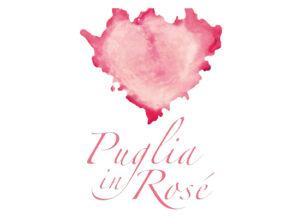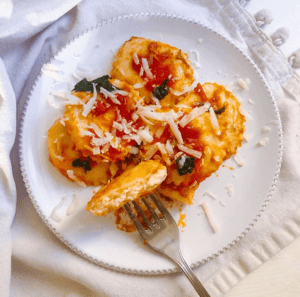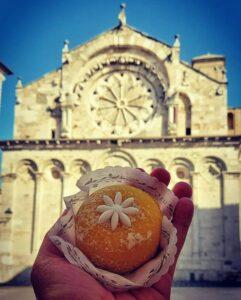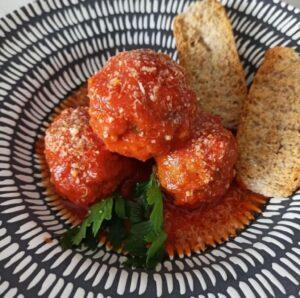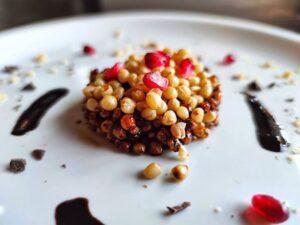Puglia: the perfect combination of food, art, and nature.
The itinerary of taste winds through the most beautiful and evocative villages of Puglia, passing through places in Castel del Monte and Monti Dauni. The hills, valleys, small villages, and cities of these territories are all custodians of local traditions and ancient recipes that enhance the natural goodness of this land. When you decide to follow one of these itineraries, you decide to explore a landscape that is intertwined with wine, oil, and the unique and exclusive local flavours, with the traditions, the welcoming hospitality, and the culture of unique and authentic places.

Itinerary:
Bari- Castel Del Monte – Andria – Saline Margherita di Savoia – Casaltrinità (Trinitapoli) – Monti Dauni – Parco Naturale Regionale Bosco dell’Incoronata – Troia – Biccari – Faeto – Orsara di Puglia
Activities:
Visit of the villages
Tasting of typical local products
Cooking workshops
Trekking
Mountain Bike
Birdwatching
Day 1
BARI
- The ancient village
- The cathedral of Bari
- The Wall of Bari
- The theatres (Petruzzelli Theatre, Margherita Theatre)
- The city center (Via Sparano, Palazzo Mincuzzi, Via Argiro, Via Melo)
Stam Street Food: typical dialect form of Bari that indicates a place, a long and narrow street. The language can only call to mind the tunnels and alleys of the Bari area most loved by visitors and locals, home to the city’s cultural and food and wine heritage: Bari Vecchia, the Borgo Antico. With its flat white stone paving, Romanesque churches and ancient walls overlooking the sea, it really feels like getting lost in the history of a city within a city.
The day will then enter the heart of the “Stam Street Food” experience with the laboratory of orecchiette and fresh pasta with the Ladies of Bari Vecchia, matriarchs of the Borgo Antico who over the years have become the symbol of our food and wine culture and our traditions.
The evening will end with the wine tasting in the Rosè Lifestyle House and the orecchiette prepared by the customers.
Bari, what to taste:
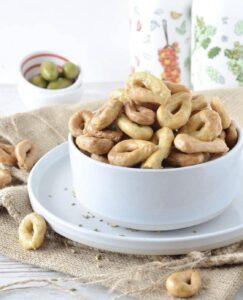 Orechiette with turnip greens is one of the best known first courses from the tradition of Apulian cuisine. It is a handmade durum wheat semolina pasta with salt and water, whose characteristic shape is reminiscent of that of small ears. They can be enjoyed freshly prepared, or with natural drying for a couple of days. The housewives in the ancient area of Bari make hand-made “l recchjtèdd” as tradition dictates.
Orechiette with turnip greens is one of the best known first courses from the tradition of Apulian cuisine. It is a handmade durum wheat semolina pasta with salt and water, whose characteristic shape is reminiscent of that of small ears. They can be enjoyed freshly prepared, or with natural drying for a couple of days. The housewives in the ancient area of Bari make hand-made “l recchjtèdd” as tradition dictates.
Taralli are an ever-present food on Apulian tables. They are a baked product with an unmistakable ring shape to be enjoyed at any time of the day. The recipe is very simple. In its dough we find only flour, white wine, extra virgin olive oil and salt.
Experience “Stam Street Food”
Stam Street Food: typical dialect form of Bari that indicates a place, a long and narrow street. The language can only call to mind the tunnels and alleys of the Bari area most loved by visitors and locals, home to the city’s cultural and food and wine heritage: Bari Vecchia, the Borgo Antico. With its flat white stone paving, Romanesque churches and ancient walls overlooking the sea, it really feels like getting lost in the history of a city within a city.
Experience "Orecchiette Day"
The day will then enter the heart of the “Stam Street Food” experience with the laboratory of orecchiette and fresh pasta with the Ladies of Bari Vecchia, matriarchs of the Borgo Antico who over the years have become the symbol of our food and wine culture and our traditions.
The evening will end with the wine tasting in the Rosè Lifestyle House and the orecchiette prepared by the customers.
Bari, what to taste:
 Orechiette with turnip greens is one of the best known first courses from the tradition of Apulian cuisine. It is a handmade durum wheat semolina pasta with salt and water, whose characteristic shape is reminiscent of that of small ears. They can be enjoyed freshly prepared, or with natural drying for a couple of days. The housewives in the ancient area of Bari make hand-made “l recchjtèdd” as tradition dictates.
Orechiette with turnip greens is one of the best known first courses from the tradition of Apulian cuisine. It is a handmade durum wheat semolina pasta with salt and water, whose characteristic shape is reminiscent of that of small ears. They can be enjoyed freshly prepared, or with natural drying for a couple of days. The housewives in the ancient area of Bari make hand-made “l recchjtèdd” as tradition dictates.
Taralli are an ever-present food on Apulian tables. They are a baked product with an unmistakable ring shape to be enjoyed at any time of the day. The recipe is very simple. In its dough we find only flour, white wine, extra virgin olive oil and salt.
Day 2
CASTEL DEL MONTE
Not far from the Adriatic coast, North-West of Bari lies the Murge plateau (l’altopiano delle Murge), the northernmost part of which is dominated by the Castel del Monte, a unique monument in the world for the skilful blend of refinement and power that characterizes it. The itinerary starts right from this fortress declared a World Heritage Site by UNESCO.
The starting point of the itinerary is a guided tour of the castle and its magnificent interior rooms – at the end of which, travellers will gather at the main entrance of the castle to leave towards the town of Andria.
Means of transport:
- Bike
- Electric Car (extra-fee)
From the outside gate of the Castle, the path winds towards Contrada Citulo to go up north-west towards the rural village of Montegrosso (ideal for trips out of town to discover nature and typical dishes of Andria), along the road known as Mediana delle Murge. Travelers, in the direction of the village, will cross the wooded area of Bosco Finizio, one of the largest in the territory of Andria. Along the way they will encounter numerous testimonies of the ancient rural culture of the area, from small trulli and jazzi, humble shelters for men and animals, to majestic examples of farmhouses, some now in ruins, others that still retain their function.
We have planned to stop at one of the typical Masserie located a few kilometers from Castel Del Monte in which travelers will be able to refresh themselves with a rich meal based on traditional Murgian products and dishes. Before the start of the meal, we thought about offering travellers a short playful moment, involving them in a “blind tasting game“.
Castel del Monte is a monumental building from the 13th century, a fortress that stands on a hill in the heart of the Bari Murge Mountains of the Alta Murgia National Park. The castle, with its distinctive octagonal shape, was built by Frederick II of Svevia. Declared a UNESCO World Heritage Site in 1996, it is a building rich in symbolism, starting with the number 8 that is recurrent throughout the structure: the octagonal shape is present in all the rooms of the castle, as is the plan of the building itself, the courtyard and the corner towers. The contrasts between the high walls built of light-colored limestone, quarried in the nearby Trani quarries, and the color of the sky offer a very special view, extremely bright during the day and well permeated at night in stargazing. Precisely because of this curious feature, it is very likely that Castel del Monte was also used as an astronomical observatory, a thesis also supported by the fact that it was precisely astronomy that represented one of the emperor’s greatest passions.
This is a tasting in the “dark” of some local products – the participants will be blindfolded and guided by our staff in a real sensory experience. In fact, several senses will be involved: relying on touch, taste and smell, where guests can go on board on a journey to discover Apulian food and wine.
Castel Del Monte, what to taste:
The Strascinati with cardoncelli mushrooms, cherry tomatoes “datterini” and parsley are a typical dish of the Apulian and Lucanian cuisine. The pasta is derived from the family of “orechiette” prepared with water and flour and is characterized by an elongated shape, this is perfect to accompany sauces of various kinds but also vegetables, such as mushrooms. The cardoncello mushroom, typical of the Murgia, is characterized by a sweet and pleasant taste so much that it can also be tasted raw, in the form of carpaccio. In combination with strascinati pasta, cherry tomatoes and parsley release all their rich and balanced taste.
In combination with this first course, we recommend a good glass of DOCG wine. The Castel del Monte Rosso Riserva DOCG has a ruby red colour, sharp and characteristic on the nose, decisive, full-bodied and harmonious taste.
At the end of the meal and after a short moment of relaxation in the greenery of the farm, travellers will resume their itinerary towards Andria. About 2km from the arrival point there is a short stop to admire the “Gurgo di Andria”, where travellers can visit the most impressive of the karst sinkholes in the area.
From “Gurgo di Andria” to Andria
Means of transport:
- Bike
- Electric Car (extra-fee)
At the end of the visit to the karst sinkhole (Dolina carsica), travellers will reach Andria. Starting from the historic centre, visitors will be able to admire the most representative points of interest of the village, such as: the Porta di S. Andrea built in the medieval period; Cathedral; the Basilica of S. Maria dei Miracoli; the Clock Tower. At the end of the short tour of the monuments of Andria, we have planned a visit to the Confectionery and the Museo del Confetto “Giovanni Mucci” located in the historic centre of Andria. Here travellers, after learning about the history of the Mucci family and the art of confectionery, will be able to taste various types of sugared almonds that is called Confetti.
At the end of the visit and tasting of the Confetti, travellers will be able to prepare customized boxes. They will then choose the colour, shape and taste of the confetti as they prefer, which will then be placed inside the elegant Mucci-branded boxes which can in turn be personalized with initials, names or symbols chosen by travellers.
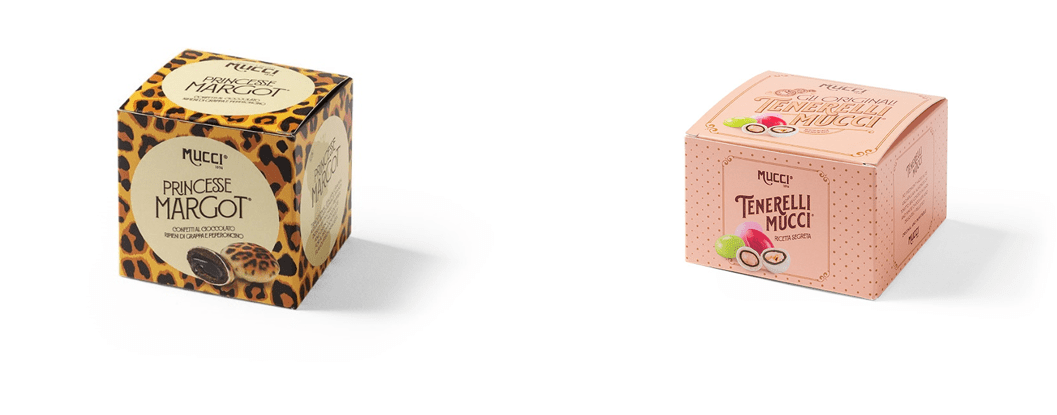
Andria, what to taste:
Burrata is a fresh cheese made from cow’s milk, with an outer layer of pasta filata containing pieces of pasta filata and cream inside. The taste is fresh, enveloping, at the same time sweet and slightly acidic. This product with a unique taste is excellent enjoyed alone but also accompanied with slices of tomato and a drizzle of extra virgin olive oil.
The “Tenerello” is a coloured sugared almond produced with Apulian almonds, covered with dark or pure white chocolate; all wrapped in a layer of extra-fine sugar.
Experience "Five Senses"
This is a tasting in the “dark” of some local products – the participants will be blindfolded and guided by our staff in a real sensory experience. In fact, several senses will be involved: relying on touch, taste and smell, where guests can go on board on a journey to discover Apulian food and wine.
Castel Del Monte, what to taste:
The Strascinati with cardoncelli mushrooms, cherry tomatoes “datterini” and parsley are a typical dish of the Apulian and Lucanian cuisine. The pasta is derived from the family of “orechiette” prepared with water and flour and is characterized by an elongated shape, this is perfect to accompany sauces of various kinds but also vegetables, such as mushrooms. The cardoncello mushroom, typical of the Murgia, is characterized by a sweet and pleasant taste so much that it can also be tasted raw, in the form of carpaccio. In combination with strascinati pasta, cherry tomatoes and parsley release all their rich and balanced taste.
In combination with this first course, we recommend a good glass of DOCG wine. The Castel del Monte Rosso Riserva DOCG has a ruby red colour, sharp and characteristic on the nose, decisive, full-bodied and harmonious taste.
Dall’ Agriturismo al “Gurgo di Andria”:
At the end of the meal and after a short moment of relaxation in the greenery of the farm, travellers will resume their itinerary towards Andria. About 2km from the arrival point there is a short stop to admire the “Gurgo di Andria”, where travellers can visit the most impressive of the karst sinkholes in the area.
From “Gurgo di Andria” to Andria
Means of transport:
- Bike
- Electric Car (extra-fee)
At the end of the visit to the karst sinkhole (Dolina carsica), travellers will reach Andria. Starting from the historic centre, visitors will be able to admire the most representative points of interest of the village, such as: the Porta di S. Andrea built in the medieval period; Cathedral; the Basilica of S. Maria dei Miracoli; the Clock Tower. At the end of the short tour of the monuments of Andria, we have planned a visit to the Confectionery and the Museo del Confetto “Giovanni Mucci” located in the historic centre of Andria. Here travellers, after learning about the history of the Mucci family and the art of confectionery, will be able to taste various types of sugared almonds that is called Confetti.
Experience "Create Your Own - Puglia Sweet Box"
At the end of the visit and tasting of the Confetti, travellers will be able to prepare customized boxes. They will then choose the colour, shape and taste of the confetti as they prefer, which will then be placed inside the elegant Mucci-branded boxes which can in turn be personalized with initials, names or symbols chosen by travellers.

Andria, what to taste:
Burrata is a fresh cheese made from cow’s milk, with an outer layer of pasta filata containing pieces of pasta filata and cream inside. The taste is fresh, enveloping, at the same time sweet and slightly acidic. This product with a unique taste is excellent enjoyed alone but also accompanied with slices of tomato and a drizzle of extra virgin olive oil.
The “Tenerello” is a coloured sugared almond produced with Apulian almonds, covered with dark or pure white chocolate; all wrapped in a layer of extra-fine sugar.
From Andria to Trinitapoli
Once in Trinitapoli in the late afternoon, travellers can dine in one of the restaurants in the country and sleep in one of the accommodations selected and recommended by us.
Day 3
From Trinitapoli to the Margherita di Savoia salt pans
After a nice and abundant breakfast, travellers will move towards the salt pans of Margherita di Savoia.
Means of transport:
- Bike
- Electric Car (extra-fee)
The salt pans of Margherita di Savoia:
The Margherita di Savoia salt pan is the largest salt mine in Italy and one of the largest in the entire Mediterranean basin. Located in the Tavoliere delle Puglie, it overlooks the Adriatic Sea from which it is separated by a thin strip of land, consisting partly of agricultural land and partly of sands.
Once at the salt pan, travellers can continue the journey on foot to discover this evocative and wonderful landscape. They will then be accompanied to the Salpi Naturalistic Observatory where they will be able to carry out birdwatching activities, admiring the most varied species of vaulted vultures present in this area, among which the pink flamingo stands out.
Picnic with a view- Tasting and a tasty lunch with view on the vineyards: Travelers will go to Trinitapoli to visit the Casaltrinità winery. Upon arrival, guests will receive everything they need for a perfect “en plein air” lunch: glasses, cutlery, plates, napkins, a bottle of DOP extra virgin olive oil and a selection of typical products of basso tavoliere of Puglia. After choosing whether to sit among the olive grove, vineyard or meadow, they will enjoy a lunch immersed in nature, during which they will have the opportunity to taste the excellent wines of the Casaltrinità Winery, expertly presented and served by the staff.
Arrival at the “Gli Orti della Nonna Evelina” Association: Travelers will arrive at the Association, a few kilometers from the city of Foggia, to enjoy a tasty aperitif in the beautiful almond grove in the hotel. “Gli orti di Nonna Evelina”, in fact, offers numerous experiences in the open countryside that are aimed at bringing guests closer to nature and rural life. After a suggestive dinner in the almond grove, travelers will stay overnight in the camping tents present in the structure, to spend a night among the unique scents and sounds of the Apulian countryside.
EVENTS TO EXPERIENCE
- ARTICHOKE FESTIVAL
The Trinitapoli Artichoke Festival is held every year at the end of November – During the festival, several stands are set up for tasting the artichoke cooked in different recipes to enhance the goodness of the product. Furthermore, during the festival, stands dedicated to craftsmanship and food and wine are set up, as well as musical and theatrical performances. The aim of the event is to promote the territory and its agricultural product par excellence – the violet artichoke.
Experience "Birdwatching - Looking For Flamingos"
Once at the salt pan, travellers can continue the journey on foot to discover this evocative and wonderful landscape. They will then be accompanied to the Salpi Naturalistic Observatory where they will be able to carry out birdwatching activities, admiring the most varied species of vaulted vultures present in this area, among which the pink flamingo stands out.
Experience "Pic-Nic with a view- Tasting and a tasty lunch with view on the vineyards"
Picnic with a view- Tasting and a tasty lunch with view on the vineyards: Travelers will go to Trinitapoli to visit the Casaltrinità winery. Upon arrival, guests will receive everything they need for a perfect “en plein air” lunch: glasses, cutlery, plates, napkins, a bottle of DOP extra virgin olive oil and a selection of typical products of basso tavoliere of Puglia. After choosing whether to sit among the olive grove, vineyard or meadow, they will enjoy a lunch immersed in nature, during which they will have the opportunity to taste the excellent wines of the Casaltrinità Winery, expertly presented and served by the staff.
From Casaltrinità to the Association "Gli Orti della Nonna Evelina" (FG)
Arrival at the “Gli Orti della Nonna Evelina” Association: Travelers will arrive at the Association, a few kilometers from the city of Foggia, to enjoy a tasty aperitif in the beautiful almond grove in the hotel. “Gli orti di Nonna Evelina”, in fact, offers numerous experiences in the open countryside that are aimed at bringing guests closer to nature and rural life. After a suggestive dinner in the almond grove, travelers will stay overnight in the camping tents present in the structure, to spend a night among the unique scents and sounds of the Apulian countryside.
Day 4
from Foggia to Troia, passing through the coronata wood
After a rich breakfast served outdoors, travellers will have the opportunity to spend the first part of the day immersed in nature.
On the property, guests will learn how to grow a vegetable garden. Expertly guided by the staff of the Association, travellers will “put their hands in the earth” to learn how to plant, choose and harvest the wide range of vegetables offered by the garden. After harvesting the vegetables and visiting the apiary located in the structure, visitors will be able to have a lunch prepared by the staff of the structure with the vegetables collected during the morning.
After the short lunch break, guests will head to Bosco dell’incoronata.
The Park includes, in addition to the woods of the Incoronata, also part of the Site of Community Importance called Valle del Cervaro. During the hike in the woods along the paths of the protected area, travelers will be able to fully appreciate the biodiversity of the Park. In addition, by entering the park, travelers will encounter the Sanctuary of the Madonna Incoronata, a renowned destination for numerous pilgrimages. Tradition has it that in April 1001 a dark wooden statue depicting the Madonna with the baby Jesus appeared to a count of Ariano Irpino and to a shepherd, among the branches of a large oak tree in the woods of Incoronata.
After an afternoon spent in nature, the itinerary includes moving to Troia.
Once in Troia, travellers will be welcomed by the D’Avalos restaurant located in the historic centre of the city.
Concetta Tursi, landlady and lady of the kitchen, with her family, will welcome guests in a small world of ancient peasant resonances. A dinner based on typical local and seasonal products will be served, naturally accompanied by a delicious glass of Nero di Troia.
Travelers can stay overnight at the B & B “Dimora Lucia”, a comfortable and welcoming accommodation in the heart of the historic centre of Troia.
Experience "Farmer For a Day - Unforgettable Rural Experience"
On the property, guests will learn how to grow a vegetable garden. Expertly guided by the staff of the Association, travellers will “put their hands in the earth” to learn how to plant, choose and harvest the wide range of vegetables offered by the garden. After harvesting the vegetables and visiting the apiary located in the structure, visitors will be able to have a lunch prepared by the staff of the structure with the vegetables collected during the morning.
After the short lunch break, guests will head to Bosco dell’incoronata.
The Regional Park of Incoronata by Bike
The Park includes, in addition to the woods of the Incoronata, also part of the Site of Community Importance called Valle del Cervaro. During the hike in the woods along the paths of the protected area, travelers will be able to fully appreciate the biodiversity of the Park. In addition, by entering the park, travelers will encounter the Sanctuary of the Madonna Incoronata, a renowned destination for numerous pilgrimages. Tradition has it that in April 1001 a dark wooden statue depicting the Madonna with the baby Jesus appeared to a count of Ariano Irpino and to a shepherd, among the branches of a large oak tree in the woods of Incoronata.
After an afternoon spent in nature, the itinerary includes moving to Troia.
Once in Troia, travellers will be welcomed by the D’Avalos restaurant located in the historic centre of the city.
Concetta Tursi, landlady and lady of the kitchen, with her family, will welcome guests in a small world of ancient peasant resonances. A dinner based on typical local and seasonal products will be served, naturally accompanied by a delicious glass of Nero di Troia.
Travelers can stay overnight at the B & B “Dimora Lucia”, a comfortable and welcoming accommodation in the heart of the historic centre of Troia.
Day 5
From Troia to Faeto, discovering the most evocative villages
After a rich breakfast, travellers will be accompanied to discover the village rich in history and points of interest, among which we mention: The Cathedral Basilica of Santa Maria Assunta, an architectural masterpiece of the eleventh century, famous for its unique rose window in the world; The Museum of the Treasure of the Cathedral of Troia inside which numerous precious works are exhibited; the frescoed churches; Palazzo D’Avolas, a seventeenth-century palace that now houses the Town Hall or the Civic Museum; numerous noble palaces.
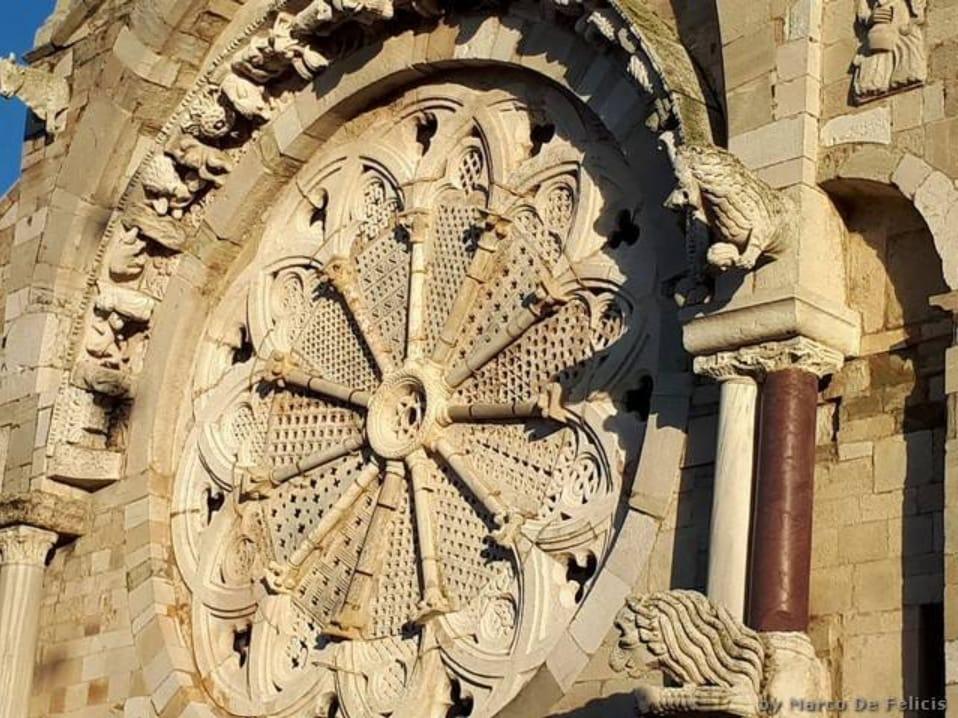
At the end of the village trip, travellers will attend a cooking workshop to learn how to prepare one of Puglia’s most loved desserts: La Appassionata.
Led by the staff of the D’Avolas restaurant, they will prepare this typical Trojan dessert based on almonds and ricotta. At the end of the activity, travelers will be offered a lunch break based on typical products, which will have dessert as its protagonist accompanied by a good glass of Nero di Troia, an intense ruby red wine with great personality and strong, typical organoleptic characteristics.
Once the activity is over, they will leave the town to head to Biccari.
Troia, what to taste:
The undisputed star of the Borgo’s food and wine is undoubtedly Nero di Troia which, when tasted in combination with traditional dishes, gives every meal a note of Apulian authenticity. It is also used in the preparation of typical dishes such as: The sausages, a punta di coltella, taralli and cheeses.
Curiosities about Troia:
Troia is rich in religious traditions that are celebrated within the village throughout the year. We recommend the Easter travel period to attend the rites of the Holy week.
Once in Biccari, travellers can decide whether to explore different nature trails and enjoy the natural paradise in which Biccari is immersed or whether to enjoy a suggestive walk through the streets of the village.
Biccari By Bike – extra excursion: A few kilometres from the centre of the city, in fact, we find the small Lake Pescara, a natural, narrow and long basin, which is located 900 m above sea level, in the middle of a naturalistic area that offers glimpses very impressive. From this site of interest, sports and trekking lovers can embark on an enchanting path that passes through the grove and the Toppo Pescara, up to the homonymous lake and Monte Sidone.
In the village, travellers can relax and refresh themselves in the historic centre and subsequently admire its architectural and artistic beauties, including: The Mother Church of Maria Assunta and Palazzo Gallo;
Biccari, what to taste:
The typical cuisine of Biccari tells the variety of flavors of the highlands of Puglia that come from the mountains, from the woods and from the plains rich in vineyards and expanses of ears: the protagonists of traditional recipes are asparagus and wild vegetables, artisan hams, pasta fresh and the numerous Doc wines. Obviously, a special role has the truffle, a local specialty found in the quality Scorzone or “summer truffle”, round and regular in shape.
Polpette della nonna are rightfully part of the Apulian culinary tradition, simple to prepare and made lavishly by grandmothers throughout the area. An ideal culinary expression of the “one pulls the other” concept, meatballs get the maximum prominence of their flavor by pairing them with tomato sauce.
Faeto, a pretty village surrounded by beautiful forests, is famous for its crisp air, good food and a ham with an unmistakable flavor.
In Faeto, travellers will be able to enjoy the beauties of the village at sunset. Among the most representative points of interest, we find:
- Historic Center: The town is gathered around narrow streets and winding alleys, which wind at the foot of the Mother Church of SS. Salvatore. As you walk, you will encounter many arches and pass through the gates of the town, which tell of an ancient and refined beauty.
- Fontana du Paije: Elegant monumental fountain of Baroque layout, with beautiful stone wash houses.
- Mother Church of SS. Salvatore: The Mother Church of Faeto is a beautiful example of Renaissance sacred architecture that dominates the village.
- The Captain’s House – Mu.Civi.Te: Delightful 15th century building, whose history is steeped in mystery;
- Il Mulino Pirozzoli: The only mill still existing in the town of Faeto, although it stopped the millstones in 1982.
After a walk through the charming village, travellers can stay overnight in the town in one of the destinations we have selected and recommended.
Faeto, what to taste:
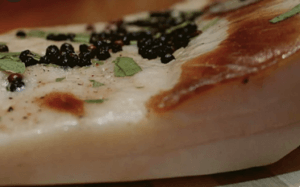 The Faeto lard, obtained from pork cuts (black Faeto pig), has the rind on the lower part, while the upper part is covered with seasoning salt, bay leaves and peppercorns. This tasty product has a homogeneous and soft consistency and a white, slightly pink color; the scent is aromatic and light, the taste is fresh, almost sweet and delicate.The lard is intended for the preparation of various typical local dishes, such as first courses and legume and vegetable soups.
The Faeto lard, obtained from pork cuts (black Faeto pig), has the rind on the lower part, while the upper part is covered with seasoning salt, bay leaves and peppercorns. This tasty product has a homogeneous and soft consistency and a white, slightly pink color; the scent is aromatic and light, the taste is fresh, almost sweet and delicate.The lard is intended for the preparation of various typical local dishes, such as first courses and legume and vegetable soups.
EVENTS TO EXPERIENCE
- EASTER IN APULIA
Easter Celebration:
- Live representation of the death of Jesus Christ: On the afternoon of Palm Sunday a multitude of young people, men and women, in period costumes, give life to the Sacred Representation of the Passion and Death of Jesus Christ;
- Procession of the Mysteries: On the evening of Santo Friday there is this scenographic procession, of Baroque and Spanish origin, which recalls the Via Crucis of the Lord;
- Procession of the Kiss: On Easter morning a peculiar rite takes place. The statue of the Madonna starts from the church of San Domenico and, in the meantime, from the church of San Francesco moves that of the Salvatore. The meeting takes place in the square in front of the Cathedral and culminates with the suggestive scene of the Kiss.
- THE PIG FESTIVAL
The first Sunday of February hosts a fixed appointment for Faeto: The Pig Festival. This evocative feast includes the tasting of pork, cooked in different manners, accompanied by the golden, crusty bread typical of Apulia. Guided tours of the town’s cured meat factories allow you to try and buy all the pork products.
- LA PARE DE VADECÒLE
La Pare De Vadecòle: On Shrove Tuesday, the Faeto carnival ends with this traveling theatrical performance.
- BONFIRES OF SAN GIUSEPPE (19 marzo)
Do not miss the processions of Holy Week, which see the apostles, the “verginelle” (the Pious Women and carrying the Addolorata on their shoulders) and the Jews, who represent the armed guards, in historical costumes.
Experience "La Passionata"
At the end of the village trip, travellers will attend a cooking workshop to learn how to prepare one of Puglia’s most loved desserts: La Appassionata.
Led by the staff of the D’Avolas restaurant, they will prepare this typical Trojan dessert based on almonds and ricotta. At the end of the activity, travelers will be offered a lunch break based on typical products, which will have dessert as its protagonist accompanied by a good glass of Nero di Troia, an intense ruby red wine with great personality and strong, typical organoleptic characteristics.
Once the activity is over, they will leave the town to head to Biccari.
Troia, what to taste:
The undisputed star of the Borgo’s food and wine is undoubtedly Nero di Troia which, when tasted in combination with traditional dishes, gives every meal a note of Apulian authenticity. It is also used in the preparation of typical dishes such as: The sausages, a punta di coltella, taralli and cheeses.
Curiosities about Troia:
Troia is rich in religious traditions that are celebrated within the village throughout the year. We recommend the Easter travel period to attend the rites of the Holy week.
From Troia to Biccari
Once in Biccari, travellers can decide whether to explore different nature trails and enjoy the natural paradise in which Biccari is immersed or whether to enjoy a suggestive walk through the streets of the village.
Biccari By Bike – extra excursion: A few kilometres from the centre of the city, in fact, we find the small Lake Pescara, a natural, narrow and long basin, which is located 900 m above sea level, in the middle of a naturalistic area that offers glimpses very impressive. From this site of interest, sports and trekking lovers can embark on an enchanting path that passes through the grove and the Toppo Pescara, up to the homonymous lake and Monte Sidone.
In the village, travellers can relax and refresh themselves in the historic centre and subsequently admire its architectural and artistic beauties, including: The Mother Church of Maria Assunta and Palazzo Gallo;
Biccari, what to taste:
The typical cuisine of Biccari tells the variety of flavors of the highlands of Puglia that come from the mountains, from the woods and from the plains rich in vineyards and expanses of ears: the protagonists of traditional recipes are asparagus and wild vegetables, artisan hams, pasta fresh and the numerous Doc wines. Obviously, a special role has the truffle, a local specialty found in the quality Scorzone or “summer truffle”, round and regular in shape.
Polpette della nonna are rightfully part of the Apulian culinary tradition, simple to prepare and made lavishly by grandmothers throughout the area. An ideal culinary expression of the “one pulls the other” concept, meatballs get the maximum prominence of their flavor by pairing them with tomato sauce.
From Biccari to Faeto
Faeto, a pretty village surrounded by beautiful forests, is famous for its crisp air, good food and a ham with an unmistakable flavor.
In Faeto, travellers will be able to enjoy the beauties of the village at sunset. Among the most representative points of interest, we find:
- Historic Center: The town is gathered around narrow streets and winding alleys, which wind at the foot of the Mother Church of SS. Salvatore. As you walk, you will encounter many arches and pass through the gates of the town, which tell of an ancient and refined beauty.
- Fontana du Paije: Elegant monumental fountain of Baroque layout, with beautiful stone wash houses.
- Mother Church of SS. Salvatore: The Mother Church of Faeto is a beautiful example of Renaissance sacred architecture that dominates the village.
- The Captain’s House – Mu.Civi.Te: Delightful 15th century building, whose history is steeped in mystery;
- Il Mulino Pirozzoli: The only mill still existing in the town of Faeto, although it stopped the millstones in 1982.
After a walk through the charming village, travellers can stay overnight in the town in one of the destinations we have selected and recommended.
Faeto, what to taste:
 The Faeto lard, obtained from pork cuts (black Faeto pig), has the rind on the lower part, while the upper part is covered with seasoning salt, bay leaves and peppercorns. This tasty product has a homogeneous and soft consistency and a white, slightly pink color; the scent is aromatic and light, the taste is fresh, almost sweet and delicate.The lard is intended for the preparation of various typical local dishes, such as first courses and legume and vegetable soups.
The Faeto lard, obtained from pork cuts (black Faeto pig), has the rind on the lower part, while the upper part is covered with seasoning salt, bay leaves and peppercorns. This tasty product has a homogeneous and soft consistency and a white, slightly pink color; the scent is aromatic and light, the taste is fresh, almost sweet and delicate.The lard is intended for the preparation of various typical local dishes, such as first courses and legume and vegetable soups.
Day 6
From Faeto to Celle di S. Vito, passing through Bosco Difesa
- Bike
- Electric car
- Horses
An uncontaminated environment, a landscape that is not ferociously man-made, made up of slow rhythms, ancient customs, ritual gestures, authentic devotion, unattainable spirituality, uninterrupted silences, authenticity and quality of the productions.
The itinerary has as its starting point Faeto and winds along the Via Franchigena dei Monti Dauni: Travelers can immerse themselves in nature thanks to the numerous nature trails in the area.
After immersing themselves in the splendid vegetation of the Capitanata, travellers will move to the town of Orsara di Puglia.
Orsara di Puglia is a pretty village surrounded by an immense natural heritage. Nature and history are two excellent reasons to visit Orsara, but the most delicious is offered by the flavors of food and wine: goat cheese cacioricotta, asparagus, durum wheat bread, wines. There are many typical products of Orsara, which is why the city has been awarded the Slow Food “Cittàslow” label. The restaurants set in the enchanting historic centre offering an ideal setting to savour every nuance of taste without haste. For the variety and usability of the tourist attractions, Orsara has also been awarded the “Orange Flag”, the Touring Club’s tourism and environmental quality mark.
After a visit to the historic Forno a Paglia in Orsara, travelers will be hosted at Peppe Zullo’s farm: Chef Peppe Zullo is recognized as one of the ambassadors of Apulian excellence in the world. For over thirty years, in fact, he has been dedicating time and care to the quality and traceability of raw materials, to rediscover the most authentic values of the Mediterranean tradition. Once at the farm, travellers can take a tour of the cellar and the vegetable garden. At the end of the short visit, guests will be offered a lunch by the chef based on typical products of the Apulian tradition, strictly at zero km.
At the end of the lunch, after a pleasant coffee break in the shade of the vineyards, guests will be expertly guided to discover the preparation of bread, pasta and other exquisite baked goods, guided by the Chef Zullo.
Orsara, what to taste:
Muscitàglia, or also called wheat of the dead, is prepared with cooked wheat, pomegranate kernels, walnuts, chocolate and vincotto, and is an ancient dessert of peasant tradition. In many towns in Apulia, on the night between November 1 and 2, it is customary to symbolically offer this dish to the souls of the departed by leaving it on the table still set.
EVENTS TO EXPERIENCE
- HALLOWEEN IN PUGLIA
On the 1st of November, an appointment with a tradition that is lost in the mists of time: the “Fucacoste and Cocce Priatorje” (Bonfires and Heads of Purgatory). The medieval village lights up with the light of hundreds of bonfires, animated by voices and music, refreshed by food and wine.
Along the streets of the village anthropomorphic pumpkins, containing lights, show the way to the souls of the dead who re-join the living in this magical night; this parade of the souls in purgatory is, according to tradition, observable in the reflections of the water mirrors of the basins placed on the doors of the houses.
The via Francigena
An uncontaminated environment, a landscape that is not ferociously man-made, made up of slow rhythms, ancient customs, ritual gestures, authentic devotion, unattainable spirituality, uninterrupted silences, authenticity and quality of the productions.
The itinerary has as its starting point Faeto and winds along the Via Franchigena dei Monti Dauni: Travelers can immerse themselves in nature thanks to the numerous nature trails in the area.
Orsara di Puglia
After immersing themselves in the splendid vegetation of the Capitanata, travellers will move to the town of Orsara di Puglia.
Orsara di Puglia is a pretty village surrounded by an immense natural heritage. Nature and history are two excellent reasons to visit Orsara, but the most delicious is offered by the flavors of food and wine: goat cheese cacioricotta, asparagus, durum wheat bread, wines. There are many typical products of Orsara, which is why the city has been awarded the Slow Food “Cittàslow” label. The restaurants set in the enchanting historic centre offering an ideal setting to savour every nuance of taste without haste. For the variety and usability of the tourist attractions, Orsara has also been awarded the “Orange Flag”, the Touring Club’s tourism and environmental quality mark.
After a visit to the historic Forno a Paglia in Orsara, travelers will be hosted at Peppe Zullo’s farm: Chef Peppe Zullo is recognized as one of the ambassadors of Apulian excellence in the world. For over thirty years, in fact, he has been dedicating time and care to the quality and traceability of raw materials, to rediscover the most authentic values of the Mediterranean tradition. Once at the farm, travellers can take a tour of the cellar and the vegetable garden. At the end of the short visit, guests will be offered a lunch by the chef based on typical products of the Apulian tradition, strictly at zero km.
Experience "Bakery - Discover the secrets of the grains"
At the end of the lunch, after a pleasant coffee break in the shade of the vineyards, guests will be expertly guided to discover the preparation of bread, pasta and other exquisite baked goods, guided by the Chef Zullo.
Orsara, what to taste:
Muscitàglia, or also called wheat of the dead, is prepared with cooked wheat, pomegranate kernels, walnuts, chocolate and vincotto, and is an ancient dessert of peasant tradition. In many towns in Apulia, on the night between November 1 and 2, it is customary to symbolically offer this dish to the souls of the departed by leaving it on the table still set.
Day 7
From Orsara di Puglia to Bari
 A farm located in Orsara di Puglia in which fresh and quality vegetables are processed and transformed into dehydrated and frozen products. Thanks to an innovative and flexible processing method, the company obtains stabilized products with nutritional and organoleptic characteristics almost identical to the fresh product. The company is renowned throughout Italy for having obtained the prestigious certificate of “Italian Excellence” and Ambassadors of Made in Italy. A recognition that underscores the bond and pride that binds them to Puglia.
A farm located in Orsara di Puglia in which fresh and quality vegetables are processed and transformed into dehydrated and frozen products. Thanks to an innovative and flexible processing method, the company obtains stabilized products with nutritional and organoleptic characteristics almost identical to the fresh product. The company is renowned throughout Italy for having obtained the prestigious certificate of “Italian Excellence” and Ambassadors of Made in Italy. A recognition that underscores the bond and pride that binds them to Puglia.
After visiting the company, Travelers will be able to taste the company’s delicious products paired with a selection of Apulian flavored oils and excellent wines from the Casaprimis Winery.
At the end of the visit, travelers will be gifted with a box containing some of the farm’s products and a recipe book, so they can replicate delicious traditional Apulian recipes at home.
A return to the city of Bari is planned in the early afternoon.
Visit to a local farm APO
 A farm located in Orsara di Puglia in which fresh and quality vegetables are processed and transformed into dehydrated and frozen products. Thanks to an innovative and flexible processing method, the company obtains stabilized products with nutritional and organoleptic characteristics almost identical to the fresh product. The company is renowned throughout Italy for having obtained the prestigious certificate of “Italian Excellence” and Ambassadors of Made in Italy. A recognition that underscores the bond and pride that binds them to Puglia.
A farm located in Orsara di Puglia in which fresh and quality vegetables are processed and transformed into dehydrated and frozen products. Thanks to an innovative and flexible processing method, the company obtains stabilized products with nutritional and organoleptic characteristics almost identical to the fresh product. The company is renowned throughout Italy for having obtained the prestigious certificate of “Italian Excellence” and Ambassadors of Made in Italy. A recognition that underscores the bond and pride that binds them to Puglia.
After visiting the company, Travelers will be able to taste the company’s delicious products paired with a selection of Apulian flavored oils and excellent wines from the Casaprimis Winery.
At the end of the visit, travelers will be gifted with a box containing some of the farm’s products and a recipe book, so they can replicate delicious traditional Apulian recipes at home.
A return to the city of Bari is planned in the early afternoon.
